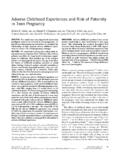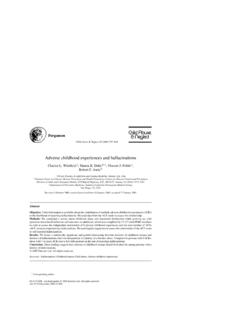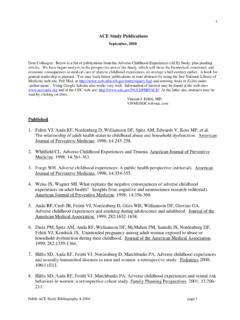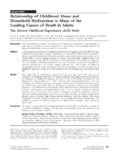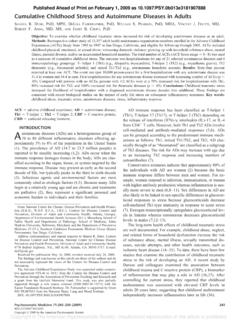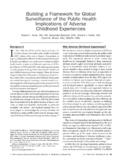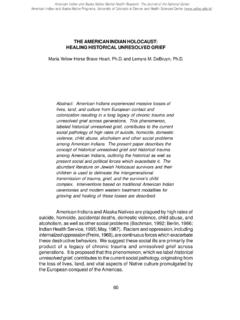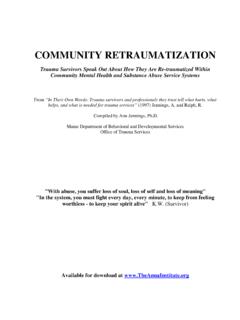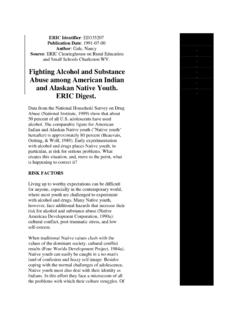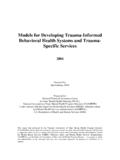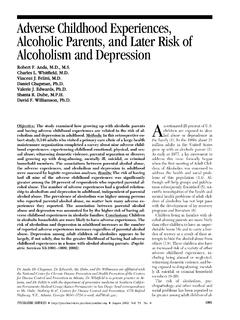Transcription of Childhood Abuse, Neglect, and Household …
1 Childhood abuse , neglect , and Household dysfunction and the Risk ofIllicit Drug Use: The adverse Childhood Experiences StudyShanta R. Dube, MPH*; Vincent J. Felitti, MD ; Maxia Dong, MD, PhD*; Daniel P. Chapman, PhD*;Wayne H. Giles, MD*; and Robert F. Anda, MD* drug use is identifiedinHealthy People 2010as a leading health indicator be-cause it is associated with multiple deleterious healthoutcomes, such as sexually transmitted diseases, humanimmunodeficiency virus, viral hepatitis, and numeroussocial problems among adolescents and adults. Improvedunderstanding of the influence of stressful or traumaticchildhood experiences on initiation and development ofdrug abuse is examined the relationship between il-licit drug use and 10 categories of adverse childhoodexperiences (ACEs) and total number of ACEs (ACEscore). A retrospective cohort study of 8613 adults whoattended a primary care clinic in California completed asurvey about Childhood abuse , neglect , and householddysfunction; illicit drug use; and other health-relatedissues.
2 The main outcomes measured were self-reporteduse of illicit drugs, including initiation during 3 agecategories:<14 years, 15 to 18 years, or as an adult (>19years); lifetime use for each of 4 birth cohorts dating backto 1900; drug use problems; drug addiction; and paren-teral drug ACE increased the likelihood for earlyinitiation 2- to 4-fold. The ACE score had a strong gradedrelationship to initiation of drug use in all 3 age catego-ries as well as to drug use problems, drug addiction, andparenteral drug use. Compared with people with 0 ACEs,people with>5 ACEs were 7- to 10-fold more likely toreport illicit drug use problems, addiction to illicit drugs,and parenteral drug use. The attributable risk fractions asa result of ACEs for each of these illicit drug use prob-lems were 56%, 64%, and 67%, respectively. For each ofthe 4 birth cohorts examined, the ACE score also had astrong graded relationship to lifetime drug ACE score had a strong graded re-lationship to the risk of drug initiation from early ado-lescence into adulthood and to problems with drug use,drug addiction, and parenteral use.
3 The persistent gradedrelationship between the ACE score and initiation ofdrug use for 4 successive birth cohorts dating back to1900 suggests that the effects of adverse Childhood expe-riences transcend secular changes such as increasedavailability of drugs, social attitudes toward drugs, andrecent massive expenditures and public informationcampaigns to prevent drug use. Because ACEs seem toaccount for one half to two third of serious problemswith drug use, progress in meeting the national goals forreducing drug use will necessitate serious attention tothese types of common, stressful, and disturbing child-hood experiences by pediatric ;111:564 572; Childhood abuse , domestic violence, drug use,substance abuse , parenteral drug ACE, adverse Childhood experience; CTS,Conflict Tactics Scale; CTQ, Childhood Trauma Questionnaire;SD, standard deviation; OR, odds ratio; CI, confidence interval.
4 ARF, attributable risk substances have been used andabused for thousands of is nowknown that illicit drug use increases the risk ofbehaviors that lead to sexually transmitted diseases,intentional and unintentional injuries, cardiac prob-lems,interpersonalviolence,disabili ty, 13 Moreover, parenteral drug use is an im-portant avenue for transmission of hepatitis B and Cand the human immunodeficiency 16Be-cause of these multiple serious consequences, sub-stance abuse is 1 of the nation s 10 leading healthindicators outlined inHealthy People 2010, which in-cludes the goal of reducing the proportion of peoplewho use illicit use is usually initiated during adolescence17;thus, many national studies have focused on mem-bers of this age group,18who often find illicit drugsreadily available. In fact, a recent national study of12- to 17-year-olds found that 55% find marijuanaeasy to , as part of a normaldevelopmental pathway, adolescents often experi-ment and behave impulsively19and seek indepen-dence and constellation of inherentbehaviors combined with easy access to drugs maycontribute to the increased risk of using illicit drugsduring 21 Despite this body of knowledge about the use ofillicit drugs, additional research is needed to under-stand and assess the influence of experiential factorsthat may contribute to the initiation and subsequentproblems with illicit drug use at any age.
5 Previousstudies suggested that early Childhood trauma canlead to an array of negative health outcomes andbehaviors, including substance abuse , among bothadolescents and 25 For example, childhoodphysical and sexual abuse has been shown to beassociated with illegal drug 28 Although theseFrom the *National Center for Chronic Disease Prevention and HealthPromotion, Centers for Disease Control and Prevention, Atlanta, Georgia;and Department of Preventive Medicine, Southern California PermanenteMedical Group (Kaiser Permanente), San Diego, for publication Mar 20, 2002; accepted Jul 22, requests to ( ) Centers for Disease Control and Prevention,National Center for Chronic Disease Prevention and Health Promotion,Division of Adult and Community Health, 4770 Buford Hwy, NE, MS K-67,Atlanta, GA 30341-3717. E-mail: (ISSN 0031 4005). Copyright 2003 by the American Acad-emy of Vol.
6 111 No. 3 March 2003studies provide evidence that most substance abus-ers come from abusive homes, many of these studieshave taken a categorical approach to examine therelationship between 1 or 2 forms of these childhoodexposures and subsequent drug abuse ; few studieshave examined illicit drug use and abuse in relationto multiple disturbing or stressful Childhood expo-sures. Previous reports from the adverse ChildhoodExperiences Study have established that forms ofchildhood abuse , neglect , and Household dysfunc-tion tend to co-occur,29,30and the effects of thesedevelopmentally disruptive Childhood experienceshave repeatedly been shown to be strong and 35 This study examined the association between 10categories of adverse Childhood experiences (ACEs): abuse (physical, emotional, or sexual); neglect (phys-ical or emotional); and growing up with householdsubstance abuse , criminality of Household members,mental illness among Household members, and pa-rental discord and illicit drug use.
7 We then use acumulative stressor model to examine the relation-ship between the number of ACEs (ACE score) andthe initiation of illicit drug use by three age catego-ries. We assess the relationships between the ACEscore and lifetime use of illicit drugs for four succes-sive birth cohorts dating back to 1900, problems withillicit drug use, addiction to illicit drugs, and paren-teral drug use. Finally, we estimate the proportion ofeach of these three serious problems of drug abusethat are attributable to adverse Childhood adverse Childhood Experiences (ACE) Study is a collabo-ration between the Kaiser Health Plan s Health Appraisal Centerin San Diego, CA, and the Centers for Disease Control and Pre-vention. The overall objective is to assess the impact of numerous,interrelated, ACEs on a wide variety of health behaviors ACE Study was approved by the InstitutionalReview Boards of the Southern California Permanente MedicalGroup (Kaiser Permanente), Emory University, and Office of Hu-man Research Protection, Department of Health and Human Ser-vices (formerly Office of Protection from Research Risks, NationalInstitutes of Health).
8 Recent publications from the ACE Studyhave shown a strong, graded relationship between the number ofACEs and the leading causes of death in the United States29andpriority health and social problems such as smoking,30unintendedpregnancies,31sexual ly transmitted diseases,32male involvementin teen pregnancy,33alcohol problems,34and attempted PopulationThe study population included adult members of the KaiserHealth Plan who received a standardized medical and biopsycho-social examination at Kaiser s Health Appraisal Center in SanDiego, CA. In any 4-year period, 81% of adult members receivedthe examination, and 50 000 members receive it annually. Theprimary purpose of the evaluation is to perform a complete healthassessment rather than provide symptom- or illness-based ACE Study consisted of 2 survey waves (wave I and wave II).Wave I was conducted among 13 494 consecutive members whoattended the Health Appraisal Center between August 1995 andMarch 1996, and the response rate was 70% (n 9508).
9 Wave IIwas conducted between June and October 1997 among 13 330members, and the response rate was 65% (n 8667). The overallresponse rate was 68% (18 175 of 26 824).The ACE questionnaire was mailed to each member 2 weeksafter his or her evaluation at the Health Appraisal Center andcontained detailed information about ACEs, including abuse (emotional, physical, or sexual) or Household dysfunction (paren-tal separation or divorce, domestic violence, substance Abuse, crime, or mental illness) as well as additional information abouthealth-related behaviors from adolescence to adulthood. Thewave II questionnaire added questions to obtain more thoroughinformation about health topics shown to be important during theanalysis of wave I ,31 For these analyses, we used data fromwave II only, because it included detailed questions about illicitdrug use that were not included in the wave I of Representativeness, and Response orReporting BiasAs part of the wave I study design, the standardized healthexamination data from the clinic visit were abstracted for bothrespondents and nonrespondents to the ACE Study questionnaire.
10 This enabled a detailed assessment of the study population interms of possible bias in demographic characteristics and health-related nonrespondents tended to be younger,less educated, or from racial/ethnic minority groups, the proba-bilities of both psychosocial and health problems were remarkablysimilar between respondents and nonrespondents after control-ling for demographic differences. In addition, assessment of therelationships between Childhood sexual abuse and numeroushealth behaviors, diseases, and psychosocial problems that wereabstracted from data from the Health Appraisal Center showedthat they were virtually identical for respondents and , there was no evidence that respondents were biasedtoward attributing their health problems to Childhood experiencessuch as sexual From the Study CohortWe excluded 3 respondents with missing information aboutrace and 35 with missing information about educational attain-ment.
